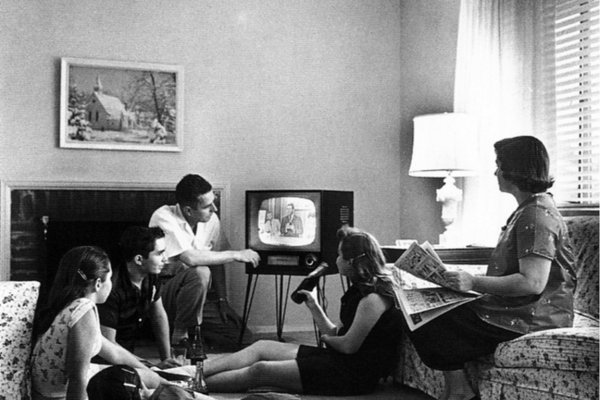This is an artistic exploration of the culture of memory, which at this time underwent huge changes due to the influence of the mass media. Film and television personalise the depiction of events, provoking an emotional sympathy that has an impact both on individual and collective memory processes.
As a medium of memory, television on the one hand generates personal sympathy, while on the other hand creating a distance from events. Niklas Luhmann notes that the observation of an event conveyed by the media is in fact an observation of second order. Within this context, sofa68 examines whether one can also talk of a memory of second order. The focus here is less on personal stories than on events transmitted by television and our memory of these.
Besides the fact that the mass media produces a kind of collective memory that is not true to reality, it is also neither an objective conveyor of reality nor a neutral record. Based on an intentional and symbolic construction, institutions and organisations manufacture a collective memory that sets itself apart from individual memory due to the narrative structure. History is reduced to a statement, generalised and made into something that can be handed down to future generations.
According to Harald Welzer, perceived and real pasts have far-reaching consequences for the establishment of cultural and social affiliations and impact on the negotiation of political positions.
“If it were to be said of May ’68 that it was just a revolutionary carnival, then this only goes to show that a hostile way of thinking cannot tolerate the revolution being a party, and that rebelling against authority can be a beautiful thing.”
[Peter Gente in “Adorno für Ruinenkinder” (Adorno for Children of the Rubble, by Heinz Bude]
In the sitting room – Schlager party pop and hits of the 60s
Schlager party pop and rock music from two CD compilations are transformed into the soundscape of the retro-hype, modular synthesizer. As a contemporary cognitive instrument, the computer analyses the music in terms of sequences, pitch and dynamic. The resulting data control the synthesizer. Resynthesized rock music can be heard on the left of the sofa, while Schlager pop music plays on the right. The projection references the 1960s sitting room, music videos of the time are shown on the television. The original music plays via the headphones.
In the waiting room of the revolution
Excerpts from speeches and radio programmes with Rudi Dutschke control actuators that make the chairs vibrate. The projection shows images from Rudi Dutschke’s appearances and scenes from the universities and lecture halls.
In the waiting room of the revolution one can just stand to one side as an observer, or one can personally feel the echo of the movement by sitting on a chair. Rudi Dutschke’s original voice can be heard via the headphones.
On the massage table
A video can be watched using VR goggles while relaxing to automatically generated ambient music. Images of various war zones are played to the left and right eye; one eye sees scenes from Vietnam, while the other sees Syria. A war that triggered a global outcry, merged with a current conflict, now almost forgotten due to its duration and length. Also used for training in battle situations, contemporary VR technology is doubly alienated.
The book table
Loans and books from private collections about the theory and practice of the 1960s and 70s. Visitors are asked to choose a text and read it. These readings are recorded by a camera and can be seen and heard on a tablet on the table. This media library is regularly updated with new readings.
The projections
In texts and animations in 2- and 3-D formats, three projections show quotes and slogans from the 60s and from secondary literature. The effects employed disrupt the seriousness and aesthetics of the original. Can the meaning of texts from the time withstand the ugly distortions? Further texts and quotes will be added during the course of the exhibition.
The window display
In the window, the most important global events of the 60s are shown only in written form and in chronological order – plain, like closing credits – such as the student protests, workers’ struggles or anticolonial movements.
“Why don't we go back, Ede? Revolution's breaking out across Europe and we're up here on this roof masquerading as artists.” [from “Raw Material” by Jörg Fauser, trans. Jamie Bulloch]
Material: Ruhestörung by Hans Dieter Müller and Günther Hörmann (1967); Vietnam Herbst 1968 by Peter Scholl-Latour (1968); Rudi Dutschke “Das Problem der Revolution in Deutschland”, speeches, debates and interviews (1967-1973), CD Box “Das 60er Jahre Schlagerkarussell”; CD Box “The Spirit of 68”; various Youtube videos; videos from the Internet archive.
At Symposium mit Unterhaltung on 7.12.2018 we will be cooking and eating and discussing emancipatory approaches and theories from the 1960s and their possible consequences in a relaxed atmosphere.
In Power Point Panic IV – 1968 on 11.12.2018, historian, exhibition-maker and design theoretician Karl Stocker meets Seppo Gründler as sound and image projector.
The performance 1968 auf dem Sofa by the Umherschweifende Produzenten on 17.1.2019 takes a look at what remains of May 68. Source materials include interviews with contemporary witnesses in Austria, the Czech Republic, England, Slovenia and Germany.





